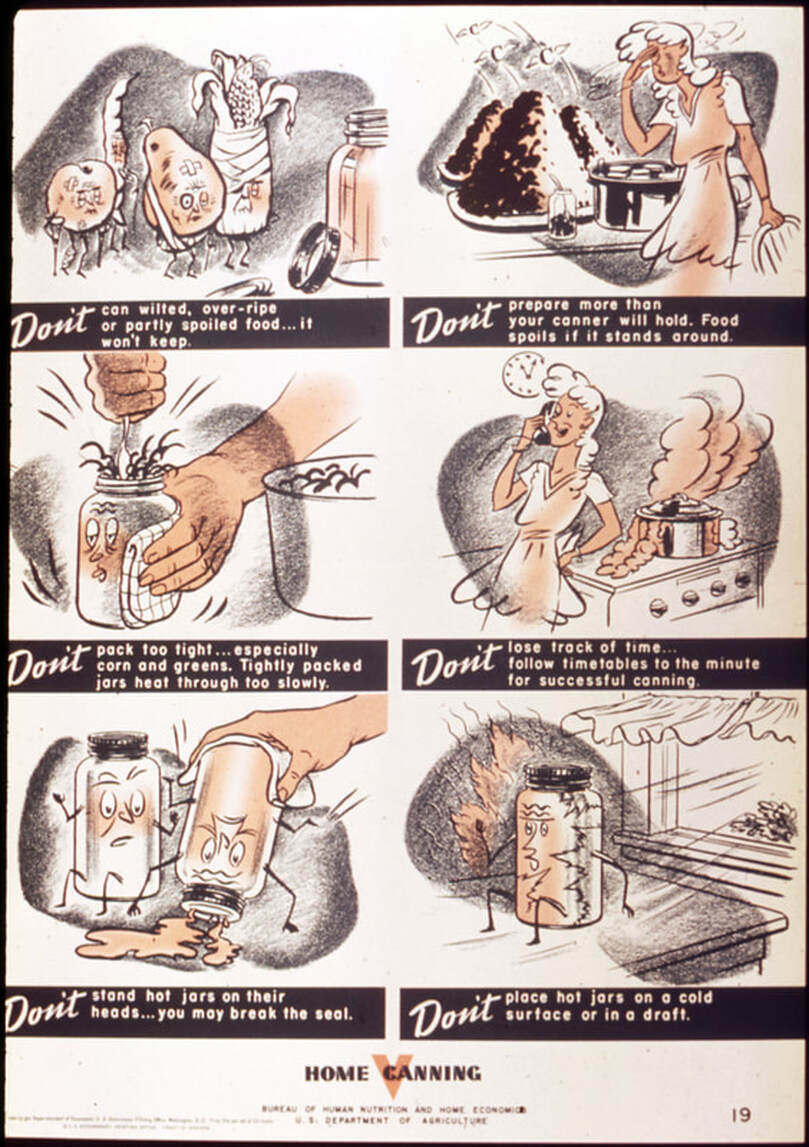|
It's prime canning season! If you're facing a glut of tomatoes or more than ready for apple picking so you can make your own sauce, this post is for you. During both World Wars, home food preservation was vital to freeing up supplies of commercially canned goods for feeding soldiers and the Allies. But not everyone was used to canning at home, and even those who were experienced sometimes relied on unreliable or dangerous methods. For instance, my great-grandmother oven canned, which is no longer considered safe. And some folks still try to turn their jars upside down for a seal, which is not recommended. All canned foods work by creating a sterile vacuum seal. High-acid foods like fruit, tomatoes, and vinegar pickled foods can be canned in a water bath, where boiling water (212 F) kills bacteria and seals the jars. Low-acid foods like non-pickled vegetables and meats need to be pressure canned. The pressure canner increases the pressure inside the chamber, which allows water to boil at a much higher temperature. This kills all bacteria, including deadly botulism, and makes the low-acid foods safe to can. One of the ways home economists and the federal government tried to educate people about canning and food safety was through propaganda posters like this one. Here's the advice from the poster: "Don't can wilted, over-ripe or partly spoiled food... it won't keep." If you wouldn't eat it fresh, you shouldn't can it. Although lots of rhetoric during the war was about saving food and preventing waste, canning can only preserve, not restore the quality of food. Poor-quality ingredients makes for poor-quality canned goods, wasting time and effort. "Don't prepare more than your canner will hold. Food spoils if it stands around." Canning takes time, and leaving cut fruits or vegetables lying around waiting to be put into jars makes them more susceptible to collecting bacteria or spoiling. Canning depends on sterile jars and fresh ingredients. Although it can be tempting to work ahead, time your work carefully to avoid waiting. "Don't pack too tight... especially corn and greens. Tightly packed jars heat through too slowly." Canned goods need to be heated through entirely to create a proper vacuum seal and prevent the growth of bacteria. Especially for low-acid foods like corn and greens, proper heating is essential to successful canning. Tightly packed jars not only risked spoilage, they also wasted fuel as it would take them longer to heat through, if at all. "Don't lose track of time... follow timetables to the minute for successful canning." We've all been there. That's what kitchen timers are for. While over-cooking doesn't usually hurt, under-cooking can result in improper seals. Better to use the timer and be sure. Test kitchens and home economists and scientists developed the time tables to ensure a minimum amount of time in the boiling water bath or pressure cooker to ensure adequate seal and food safety. "Don't stand hot jars on their heads... you may break the seal." Although some people still do this to "ensure a good seal," a heat seal is not the same as a vacuum seal, and liquids touching the tops of the cans before they are fully cooled may break the seal and allow air and bacteria in, leading to spoilage. "Don't place hot jars on a cold surface or in a draft." They may break or explode. Seriously. This is also why canning jars need to be heated before filling - not only for sterilization, but also to prevent shock and cracks or breakage. Canning can be intimidating, and certainly time-consuming, but the push to get Americans to participate in home food preservation was a hard one. Although it can be difficult to balance the effort of canning with modern lives, the urgency of food preservation during World War II meant people carved out the time to make the effort. Do you can at home? I usually don't have the time, although nothing beats home canned applesauce (at least, my mom's style) and jam. A friend of mine keeps me supplied with amazing homemade jams. They're worth every penny. Especially since then I don't have to do the canning myself! Share your canning memories and stories (or horror stories) in the comments! The Food Historian blog is supported by patrons on Patreon! Patrons help keep blog posts like this one free and available to the public. Join us for awesome members-only content like free digitized cookbooks from my personal collection, e-newsletter, and even snail mail from time to time! Don't like Patreon? Leave a tip!
0 Comments
Your comment will be posted after it is approved.
Leave a Reply. |
AuthorSarah Wassberg Johnson has an MA in Public History from the University at Albany and studies early 20th century food history. Archives
July 2024
Categories
All
|


 RSS Feed
RSS Feed